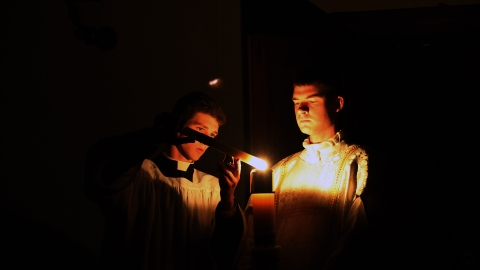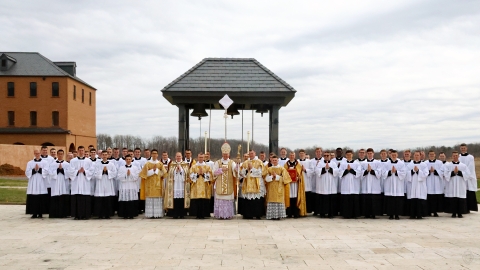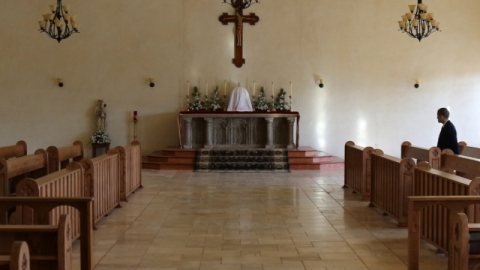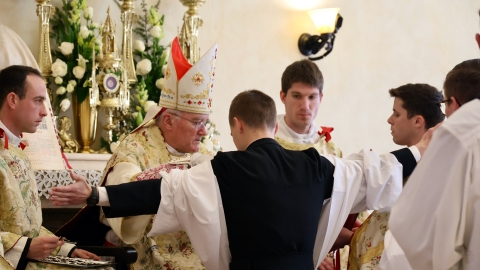Miraculous Medal Campaign

The Miraculous Medal
The Miraculous Medal is one of the Church's sacramentals. It is a physical representation of a spiritual reality. Ever since its institution, the Miraculous Medal has been known to be a powerful source of drawing down God's grace to mankind, even in the form of miracles. That is why the Seminary is launching its Miraculous Medal Campaign. Help spread this marvelous devotion to Our Lady by requesting your medals here!
As the medals are already blessed they cannot be sold as such. However, we are asking a for nominal fee to cover our shipping costs. Please note, prices have increased due to increased price of postage.
What is a Miraculous Medal?
The Miraculous Medal is a sacramental, a means of disposing one’s soul to receive grace. The two main effects of a sacramental are to cleanse venial (lesser) sins by disposing the heart to sorrow for sin, and to help in overcoming temptations. A sacramental is not a good luck charm, or some kind of get-into-heaven free card. Rather, it is a link between earth and heaven, a physical manifestation of the spiritual reality of God’s love for us, and for the intercession of His Mother. Like a locket that contains the picture of our mother, the Miraculous Medal reminds us of her, and helps us to call on her and speak to her when we are in trouble. And because God wants us to use physical sacramentals to remind ourselves of spiritual realities, he grants his grace in a special way to those who use them in this way.
What does the Medal mean?
On the front of the Medal, Our Lady stands upon a globe representing the earth, and crushing a serpent representing the devil (see Genesis 3:15). The rays streaming from her hands signify the graces that she pours out upon those who ask her intercession with her Son. The date 1830 refers to the year of the vision of St. Catherine Laboure.
On the back of the Medal, the Sacred Heart of Our Lord and the Immaculate Heart of Our Lady are the symbols of their burning love for us. The Sacred Heart is surrounded by a crown of thorns. The Immaculate Heart is pierced with a sword, showing the grief of Our Lady, as foretold by the prophet Simeon (Luke 2). The Cross is a sign of the Redemption accomplished by Christ, and it rests on a bar which is the earth. The M stands for Mary, and the interweaving of the Cross and M show her role in assisting the Redemption. The twelve stars probably refer to the Apostles, who represent the whole Church, standing around Jesus and Mary (Apocalypse 12:1).
The Story of St. Catherine Laboure
Catherine Laboure was born in 1806 on a farm in northern France. In 1829 she entered a convent of the Sisters of Charity, an order of nuns who primarily work as hospital nurses. One day as she and her sisters were in the chapel doing their evening meditation, she saw a vision of a beautiful Lady standing upon a globe, with rings with gemstones upon her fingers that shed a bright light down upon the globe, and she knew it was Our Lady. The Blessed Virgin told her “these rays symbolize the graces I shed upon those who ask for them. The gems from which rays do not fall are the graces for which souls forget to ask.” Catherine then saw written around her in letters of gold the words “O Mary, conceived without sin, pray for us who have recourse to thee.” Catherine was then told, “Have a Medal struck after this model. All who wear it will receive great graces; they should wear it around the neck. Graces will abound for persons who wear it with confidence.”
Catherine described the medal to her spiritual director and the first few were made under his direction, for she wished her own identity to remain secret. Although the Medal became instantly popular throughout the world, the identity of Sister Catherine was successfully hidden from the public for forty-six years, despite constant attempts to discover the visionary. Many miracles were soon reported by people who had worn the medal and recited the prayer, especially conversions and cures of those hopelessly sick, which led to its being named “The Miraculous Medal.” But during all this time, Catherine remained at her hospital, working as an obscure nurse. She died in 1876.
Stories of miraculous favors connected with the Medal.
Alphonse Ratisbonne was an agnostic lawyer and banker, with a strong hatred for Catholicism. In a chance meeting, an old friend of his dared him to wear the medal and recite the prayer, and see if he could remain unchanged. Ratisbonne took the dare, and the prayer began to echo in his mind, “like one of those songs from an opera which you sing without thinking of them, and then feel annoyed at yourself for singing it.” He began to have dreams of the cross, which disturbed him from getting any rest. While looking at the architecture in a church, he saw a vision of Our Lady, so beautiful that he could not bear to look upon her directly, but could only stare at her hands, which “expressed all the secrets of the divine pity.” He was immediately convinced of the truth of the Catholic Faith, was baptized, became a priest, and spent his life as a missionary.
Claude Newman was a poor African-American man, who lived in Mississippi. He was sent to jail for murder in 1942. One night during a quarrel with his cellmates, a Miraculous Medal was thrown down by someone, and Claude picked it up. That night, he awoke to a touch on the wrist, and saw a beautiful Lady standing near, who said “If you would like me to be your mother, and you would like to be my child, send for a priest of the Catholic Church.” He awoke the prison shouting for a priest, and asked to take religious instruction when one came. The priest was amazed, in the course of this instruction, to find that this illiterate young man had already been instructed in many things by some unknown person. Claude reminded the priest of a secret vow that he had made to Our Lady while lying in a ditch during the Second World War that remained unfulfilled. Claude amazed everyone who knew him by the change that had come over him, desiring death so that he could be united with God, and offering his death for the conversion of another prisoner who hated him. He asked for a party with the other prisoners to celebrate his own execution, and went to his death “beaming with happiness.”
Catherine Laboure, the visionary who gave us the Medal, nursed the sick for her entire life without public recognition for her marvelous vision, at one point even denying a private interview to Pope Gregory XVI. When her tomb was opened in 1933, almost sixty years after she died, her body was found to be perfectly preserved with no signs of decay. Her eyes were still blue, and her arms and legs were still flexible, as though she was merely asleep. The body remains in that condition to this day, and can be seen in the chapel of the Sisters of Charity at Rue de Bac, Paris.





